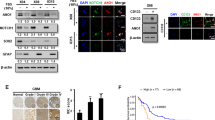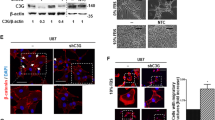Abstract
Glioblastoma multiforme is the most undifferentiated type of brain tumor, and its prognosis is extremely poor. Glioblastoma cells exhibit highly migratory and invasive behavior, which makes surgical intervention unsuccessful. Here, we showed that glioblastoma cells express Ca2+-permeable α-amino-3-hydroxy-5-methyl-4-isoxazolepropionate (AMPA)-type glutamate receptors assembled from the GluR1 and/or GluR4 subunits, and that their conversion to Ca2+-impermeable receptors by adenovirus-mediated transfer of the GluR2 cDNA inhibited cell locomotion and induced apoptosis. In contrast, overexpression of Ca2+-permeable AMPA receptors facilitated migration and proliferation of the tumor cells. These findings indicate that Ca2+-permeable AMPA receptors have crucial roles in growth of glioblastoma. Blockage of these Ca2+-permeable receptors may be a useful therapeutic strategy for the prevention of glioblastoma invasion.
This is a preview of subscription content, access via your institution
Access options
Subscribe to this journal
Receive 12 print issues and online access
$209.00 per year
only $17.42 per issue
Buy this article
- Purchase on Springer Link
- Instant access to full article PDF
Prices may be subject to local taxes which are calculated during checkout






Similar content being viewed by others
References
Kleihues, P. et al. Glioblastoma. World Health Organization Classsification of Tumours. in Pathology and Genetics of Tumours of the Nervous Systems (eds. Kleihues, P. & Cavenee, W.K.) 29–39 (IARC Press, Lyon, France, 2000).
Blakemore, W.F., Franklin R.J.M. & Noble, M. Glial cell transplantation and the repair of demyelinating lesions. In Glial Cell Development (ed. Jessen, K.R. & Richardson, W.D.) 209–220 (BIOS Scientific Publishers, Oxford, UK. 1996).
Noble, M. et al. From rodent glial precursor cell to human glial neoplasia in the oligodendrocyte-type-2 astrocyte lineage. Glia 15, 222–230 (1995).
Gallo, V. & Ghiani, C.A. Glutamate receptors in glia: New cells, new inputs and new functions. Trends Pharmacol. Sci. 21, 252–258 (2000).
Chew, L.-J. et al. Growth factor-induced transcription of GluR1 increases functional AMPA receptor density in glial progenitor cells. J. Neurosci. 17, 227–240 (1997).
Gallo, V., Wright, P. & McKinnon, R.D. Expression and regulation of a glutamate receptor subunit by bFGF in oligodendrocyte progenitor cells. Glia 10, 149–153 (1994).
Meucci, O., Fatatis, A., Holzwarth, A. & Miller, R.J. Developmental regulation of the toxin sensitivity of Ca2+-permeable AMPA receptors in cortical glia. J. Neurosci. 16, 519–530 (1996).
Labrakakis, C., Patt, S., Hartmann, J. & Kettenmann, H. Glutamate receptor activation can trigger electrical activity in human glioma cells. Eur. J. Neurosci. 10, 2153–2162 (1998).
Yoshioka, A., Ikegaki, N., Williams, M. & Pleasure, D. Expression of N-methyl-D-asparate (NMDA) and non-NMDA glutamate receptor genes in neuroblastoma, medulloblastoma, and other cells lines. J. Neurosci. Res. 46, 164–178 (1996).
Seeburg, P.H. The molecular biology of mammalian glutamate receptor channels. Trends Neurosci. 16, 359–365 (1993).
Hollmann, M. & Heinemann, S. Cloned glutamate receptors. Annu. Rev. Neurosci. 17, 31–108 (1994).
Ozawa, S., Kamiya, H. & Tsuzuki, K. Glutamate receptors in the mammalian central nervous system. Prog. Neurobiol. 54, 581–618 (1998).
Kohara, A. et al. In vitro characterization of YM872, a selective, potent and highly water-soluble α-amino-3-hydroxy-5-methylisoxazole-4-propionate receptor antagonist. J. Pharm. Pharmacol. 50, 795–801 (1998).
Iino, M. et al. Glia-synapse interaction through Ca2+-permeable AMPA receptors in Bergmann glia. Science 292, 926–929 (2001).
Ishiuchi, S. et al. Extension of glial processes by activation of Ca2+-permeable AMPA receptor channels. Neuroreport 12, 745–748 (2001).
Cotrina, M.L., Lin, J.H.-C. & Nedergaard, M. Cytoskeletal assembly and ATP release regulate astrocytic calcium signaling. J. Neurosci. 18, 8794–8804 (1998).
Steller, H. Mechanisms and genes of cellular suicide. Science 267, 1445–1449 (1995).
Khine, M.M. et al. Analysis of relative proliferation rates of Wilms' tumor components using proliferating cell nuclear antigen and MIB-1 (Ki-67 equivalent antigen) immunostaining and assessment of mitotic index. Lab. Invest. 70, 125–129 (1994).
Gallo, V., Kingsbury, A., Balazs, R. & Jorgensen, O.S. The role of depolarization in the survival and differentiation of cerebellar granule cells in culture. J. Neurosci. 7, 2203–2213 (1987).
Koike, T., Martin, D.P. & Johnson, E.M. Jr. Role of Ca2+ channels in the ability of membrane depolarization to prevent neuronal death induced by trophic factor deprivation: Evidence that levels of internal Ca2+ determine nerve growth factor dependence of sympathetic ganglion cells. Proc. Natl. Acad. Sci. USA 86, 6421–6425 (1989).
Yano, S., Tokumitsu, H. & Soderling, T.R. Calcium promotes cell survival through CaM-K kinase activation of the protein-kinase-B pathway. Nature 396, 584–587 (1998).
Takano, T. et al. Glutamate release promotes growth of malignant gliomas. Nature Med. 7, 1010–1015 (2001).
Bezzi, P. et al. Prostaglandins stimulate calcium-dependent glutamate release in astrocytes. Nature 391, 281–285 (1998).
Sasaki, A. et al. Expression of interleukin-1β mRNA and protein in human gliomas assessed by RT-PCR and immunohistochemistry. J. Neuropathol. Exp. Neurol. 57, 653–663 (1998).
Rzeski, W., Turski, L. & Ikonomidou, C. Glutamate antagonists limit tumor growth. Proc. Natl. Acad. Sci. USA 98, 6372–6377 (2001).
Ishiuchi, S. & Tamura, M. Central neurocytoma: An immunohistochemical, ultrastructural and cell culture study. Acta Neuropathol. (Berl.) 94, 425–435 (1997).
Ishiuchi, S. et al. In vitro neuronal and glial production and differentiation of human central neurocytoma cells. J. Neurosci. Res. 51, 526–535 (1998).
Sakurai, T. & Okada, Y. Selective reduction of glutamate in the rat superior colliculus and dorsal lateral geniculate nucleus after contralateral enucleation. Brain Res. 573, 197–203 (1992).
Miyake, S. et al. Efficient generation of recombinant adenoviruses using DNA-terminal protein complex and a cosmid bearing the full-length virus genome. Proc. Natl. Acad. Sci. USA 93, 1320–1324 (1996).
Kanegae, Y. et al. Efficient gene activation in mammalian cells by using recombinant adenovirus expressing site-specific Cre recombinase. Nucl. Acids Res. 23, 3816–3821 (1995).
Sudo, M. et al. Postsynaptic expression of Ca2+-permeable AMPA-type glutamate receptor channels by viral-mediated gene transfer. Mol. Brain Res. 65, 176–85 (1999).
Nakazato, Y., Ishida, Y., Takahashi K. & Suzuki, K. Immunohistochemical distribution of S-100 protein and glial fibrillary acidic protein in normal and neoplastic salivary glands. Virchows Arch. A Pathol. Anat. Histopathol. 405, 299–310 (1985).
Kondo, M., Sumino, R. & Okado, H. Combinations of AMPA receptor subunit expression in individual cortical neurons correlate with expression of specific calcium-binding proteins. J. Neurosci. 17, 1570–1581 (1997).
Mogami, H., Nakano, K., Tepikin, A.V. & Petersen, O.H. Ca2+ flow via tunnels in polarized cells: recharging of apical Ca2+ stores by focal Ca2+ entry through basal membrane patch. Cell 88, 49–55 (1997).
Acknowledgements
We thank I. Saito and Y. Kanegae for materials for constructing recombinant adenoviruses; M. Kondo for DNA templates for GluR1 and GluR2 to produce RNA probes for in situ hybridization; and M. Maniwa for technical assistance.
Author information
Authors and Affiliations
Corresponding author
Ethics declarations
Competing interests
The authors declare no competing financial interests.
Rights and permissions
About this article
Cite this article
Ishiuchi, S., Tsuzuki, K., Yoshida, Y. et al. Blockage of Ca2+-permeable AMPA receptors suppresses migration and induces apoptosis in human glioblastoma cells. Nat Med 8, 971–978 (2002). https://doi.org/10.1038/nm746
Received:
Accepted:
Published:
Issue Date:
DOI: https://doi.org/10.1038/nm746
This article is cited by
-
Induction of glioblastoma invasion triggered by system Xc−-mediated glutamate release
Molecular & Cellular Toxicology (2024)
-
Dication Molecules as Tools for Studying Actylcholine and Glutamate Receptors (Review)
Pharmaceutical Chemistry Journal (2023)
-
Altered Calcium Permeability of AMPA Receptor Drives NMDA Receptor Inhibition in the Hippocampus of Murine Obesity Models
Molecular Neurobiology (2022)
-
The expression of glutamate metabolism modulators in the intracranial tumors and glioblastoma cell line
Molecular Biology Reports (2022)
-
The glutaminase (CgGLS-1) mediates anti-bacterial immunity by prompting cytokine synthesis and hemocyte apoptosis in Pacific oyster Crassostrea gigas
Scientific Reports (2021)



